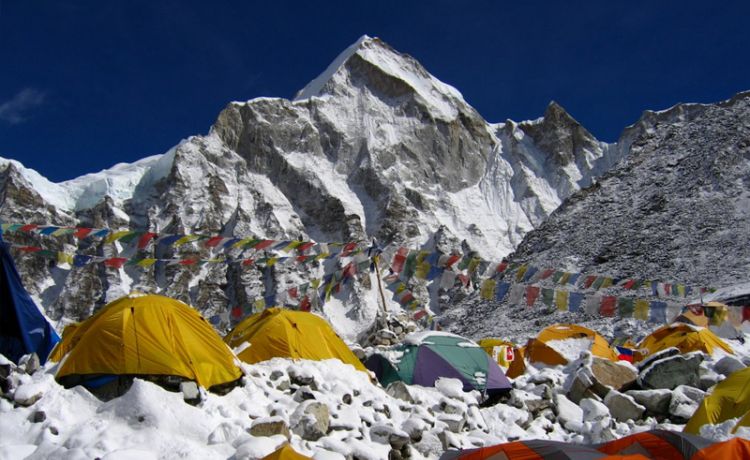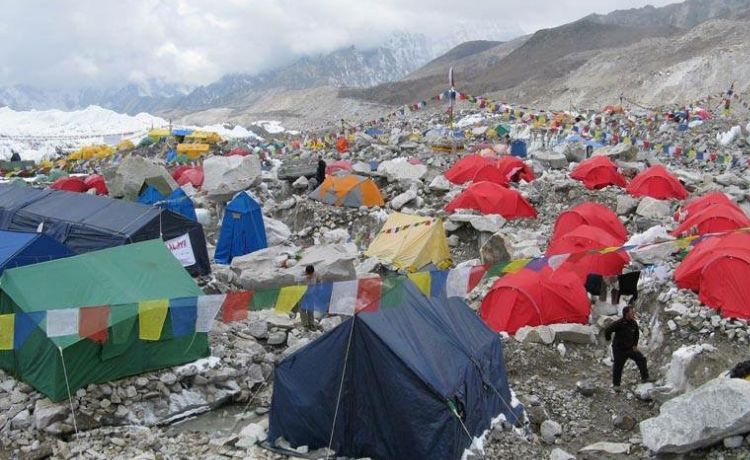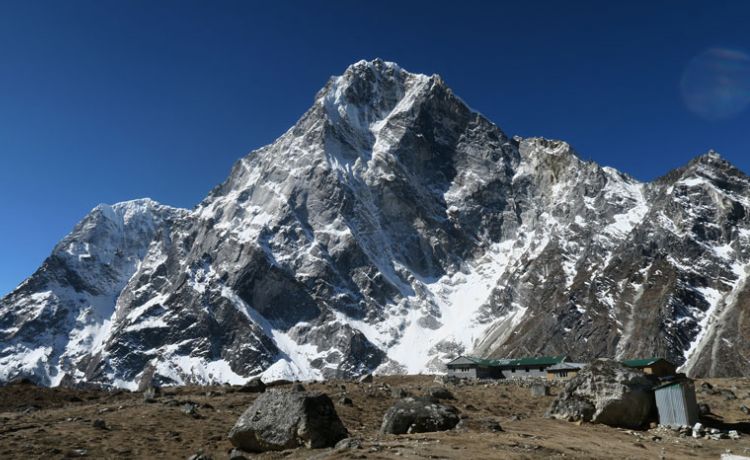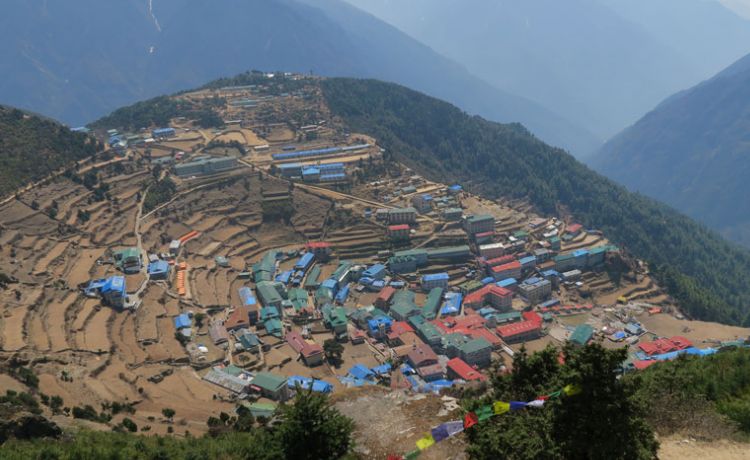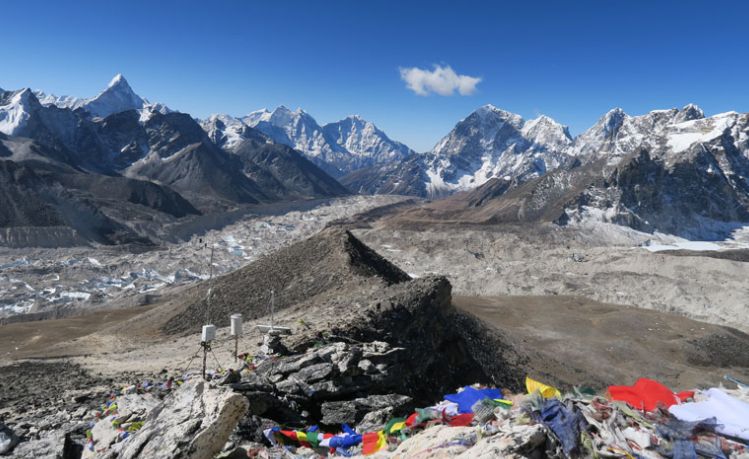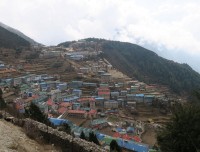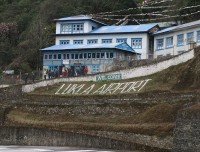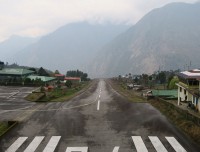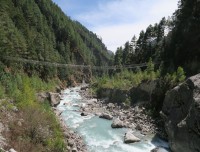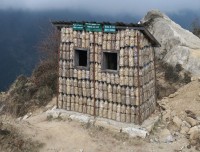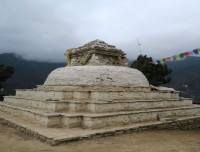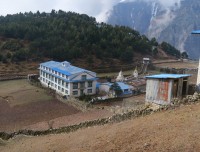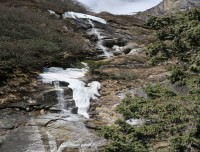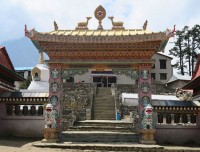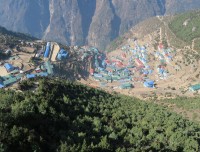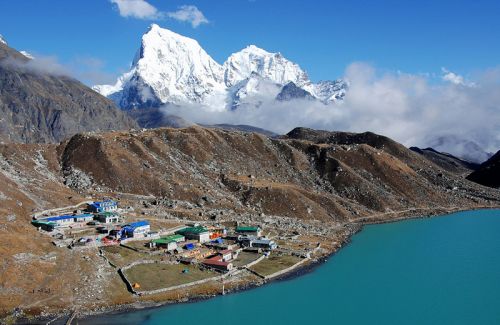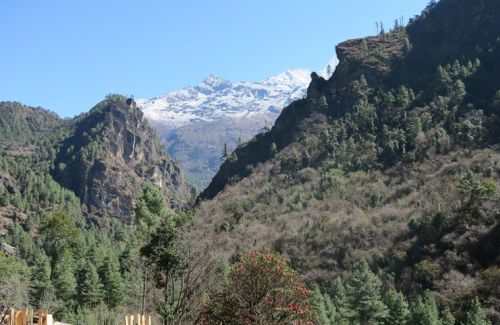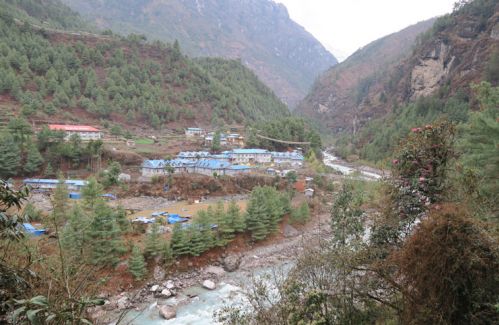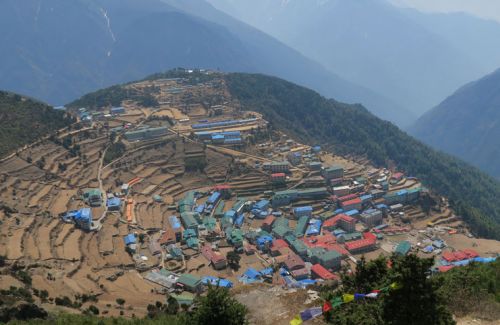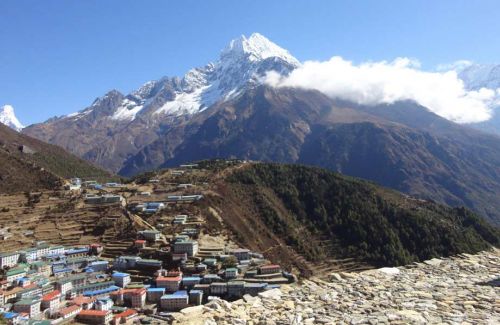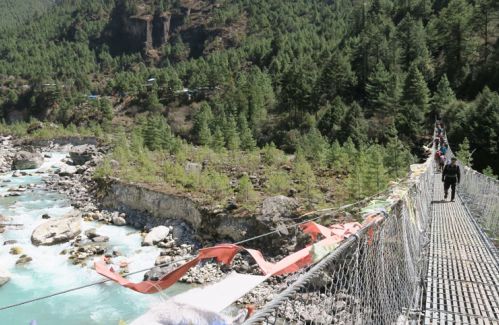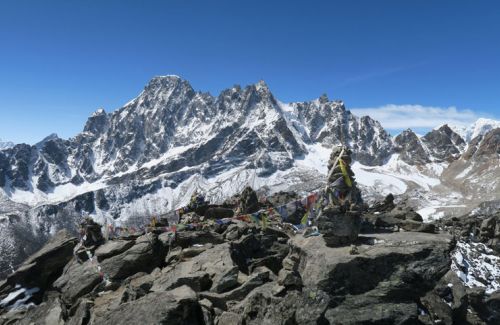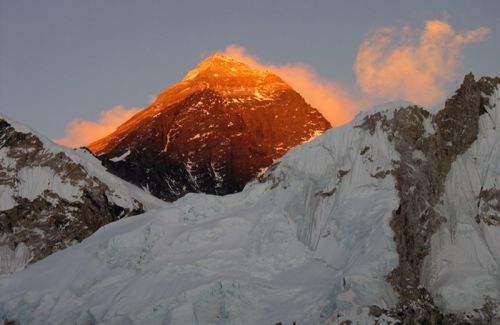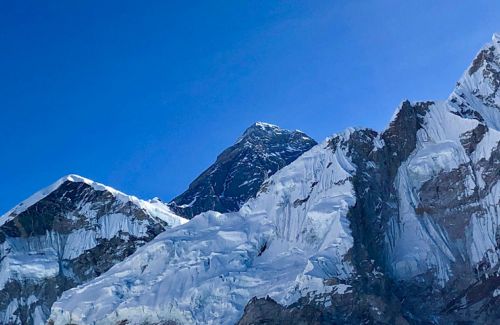Everest Base Camp Trekking
- Duration16 Days
- Max. Altitude5,545 m
- Starts FromUSD 1400
Destination:Nepal
Trip Grade:Strenuous (****)
Meals:Breakfast + Lunch + Dinner
Transportation:Private Vehicle / Aeroplane
Accommodation:Lodge
Trekking Region:Everest Region
Show All
Everest Base Camp Trekking is the popular, world’s most awe inspiring, an iconic mountain trail trek. It’s a lodge to lodge trekking. Everest Base Camp Trek has the reputation of being the grandest walk in the land of the Himalayas.The trek to Everest Base Camp, provides stunning view of Mt. Everest, Mt. Lhotse, Mt. Makalu and Cho-Oyu, four of the world’s six tallest peaks. Besides this, it has number of attractions: the outgoing Sherpa people of the Khumbu region. Everest Base Camp trek starts in Nepali-speaking Hindu lowlands and ends in the Tibetan-Buddhist highlands. It reaches a significant height of 5,545 m at the mightiest viewpoint Kalapattar. Everest Base Camp Trek further offers the opportunities to go sightseeing around Sagarmatha National Park, a world heritage site that is home to a variety of Himalayan flora and fauna.
We land at Tenzing Hillary airport at Lukla, then starts our trek to upper Phakding. This follows the Dudhkoshi river then leads to quaint Namche Bazaar, a junction for trekkers, the local Sherpas and expeditions en route to the Mt. Everest. The forest of pine, fir, black juniper and rhododendron en route is remarkable. The views from Tengboche(3,867 m) are spectacular. What a place for the monastery! it was founded in 1923 and Nyingmapa sect of Buddhism is being followed by the monks. From Tengboche, the trail heads east and descends slightly past the nunnery at Dingboche (3,757 m) continues to the river, the Imja Khola, and crosses it at a narrowing suspension bridge(3,780m) from which we get a mesmerizing view of Ama Dablam. Then we reach to Pangboche (3,901 m) where there is the oldest Gumba in Khumbu which was built some 300 years ago. According to legend, a venerable old Lama tore out of his hair and cast it around the Gumba. The large black juniper trees surrounding it sprouted from those hairs.The Gumba contains some yeti relics- a scalp and some bones. After this we will be in Pheriche (4,252 m), once it was a yak herding area and finally takes us to the Khumbu glacier and ascends to the huts of Dughla (4,593 m).
The trail then contours on the other side of the glacier after crossing another stream of melted water. The trail heads to Lobuche (4,930 m), a vantage point for the wonderful views of the Ama Dablam and other peaks. Beyond Lobuche, the trail follows,climbs the moraine.From a high point here, the rubble – covered hill of KalaPattar(5,623 m) in front of Pumori can be seen. We can also see the picturesque southwest face of the colossal Mt. Everest. After reaching the Everest Base Camp at the end of the Khumbu Icefall, we make our journey back to Lukla.
Trip Highlights
- Sightseeing in World Heritage Sites in Kathmandu
- Scenic flight from to and from Lukla
- Cultural experience in high altitude area
- Great opportunity to be with friendly Sherpa people of Khumbu region
- You could feel the vibration in Tengboche Monastery
- Majestic view of Mt. Everest and adjacent peaks
- Exploring Kalapatthar and have great sunrise view
Day to Day Itinerary
Day 01:Arrival in Kathmandu (1350 m), Transfer to Hotel. Overnight at Hotel
Day 02:Pre-Trip meeting and full day Kathmandu sightseeing. O/N at Hotel
Day 03:Fly from Kathmandu to Lukla, then trek to Phakding (2,652 m), 3 hrs. O/N at Guest House
Day 04: Trek from Phakding to Namche Bazaar (3,440 m), 5 hrs. O/N at Guest House
Day 05:Day Rest for Acclimatization at Namche Bazaar
Day 06:Trek from Namche Bazaar to Tengboche (3,870 m), 5 hrs. O/N at Guest House
Day 07:Trek from Tengboche to Dingboche (4,360 m), 6 hrs. O/N at Guest House
Day 08:Day trip to Chhukung Valley (4,730 m) and return back to Dingboche, 4 hrs. O/N at Guest House
Day 09:Trek from Dingboche to Lobuche (4,940 m), 5 hrs. O/n at Guest House
Day 10:Lobuche – Gorakshep (5,170 m) then Hike to Everest Base Camp (5,364 m), back to Gorakshep, 8 hrs.O/N at Guest House
Day 11:Early morning hike to Kalapatthar (5,550 m) and trek to Pangboche (3,930 m), 7 hrs. O/N at Guest House
Day 12:Trek from Pangboche to Khumjung Valley (3,780 m), 6 hrs. O/N at Guest House
Day 13:Trek from Khumjung Valley to Monjo (2,835 m), 6 hrs. O/N at Guest House
Day 14:Trek from Monjo to Lukla (2,840 m), 6 hrs. O/N at Guest House
Day 15:Fly from Lukla to Kathmandu (1,350 m), 30 min.O/N at Hotel
Day 16:Departure to International Airport
Cost Include
- Airport Picks up and Drops off by private tourist vehicle
- Guided city tour by private tourist vehicle
- A full day sightseeing at UNESCO World Heritage Sites in Kathmandu
- A government licensed holder city Tour Guide
- 3 nights in Kathmandu in twin sharing basis 2-3 star hotels with Breakfast
- Flight from Kathmandu - Lukla - Kathmandu
- Lodge to lodge accommodation during the trek
- Full Board meal (Breakfast + Lunch + Dinner) during the trek
- An experienced English Speaking Trekking Guide
- The required number of local staffs and Porter (2 Trekkers = 1 Porter)
- Food, accommodation, salary, insurance. equipment and medicine for guide and porter
- Sagarmatha National Park Entry Permit and TIMS Card for trekking
- Down Jacket, Duffel Bag and Sleeping Bag by Himkala Adventure (If required)
- Farewell Dinner in the typical Nepalese reataurant with Cultural Show
-
Government Taxes, VAT, and Service Charge
Cost Exclude
- Lunch and Dinner in Kathmandu
- Entrance fees in the Heritage Sites in Kathmandu
- Your Travel Insurance
- Nepal Entry Visa Fee
- Emergency Rescue and Evacuation
- Personal Expenses (Phone calls, laundry,bar bills, battery recharge, bottled or boiled water, shower etc.)
- Tips for guide and porter
- Personal Trekking Equipment
-
Any other expenses which are not mentioned in Cost Includes Section
Detail Itinerary
Day 01Arrival in Kathmandu (1350 m), Transfer to Hotel. Overnight at HotelA representative from Himkala Adventure will heartily welcome you at Tribhuvan International Airport upon your arrival. After the custom formalities, you will meet the Himkala Adventure’s representative waiting outside the arrival gate holding the company’s board, affectionately receives you and you will be transferred to the hotel. You can have rest it’s because you are having jetlag and after a while stroll around Thamel, the touristic area.Overnight stay at hotel in Kathmandu
Day 02Pre-Trip meeting and full day Kathmandu sightseeing. O/N at Hotel The day begins after having breakfast, for the day sightseeing to the UNESCO World Heritage Sites. The sites offer the splendid craftsmanship, artifacts, medieval period’s dedication to intricate work on wood and still existing ritual activities. The congenial atmosphere around temples, monasteries, and stupas are impressive with human activities. You will be given briefing about the trek after you come back to hotel from the sightseeing. Overnight at Kathmandu
Day 03Fly from Kathmandu to Lukla, then trek to Phakding (2,652 m), 3 hrs. O/N at Guest House You will be escorted to the domestic terminal at Tribhuvan Airport for the early morning flight to Lukla. It’s 40 minutes flight from the height 1,350 m to the 2,800 m at Tenzing-Hillary airport to Lukla. The stimulating flight with scintillating Himalayan view leaves you indescribable impression. Upon your arrival at Lukla,Himkala crews are eagerly waiting to greet you and make the trip organized. You begin to hike to Phakding which assist you to acclimatize and adjust with the mountainous atmosphere. You can explore around in your spare time. Overnight at Phakding
Day 04 Trek from Phakding to Namche Bazaar (3,440 m), 5 hrs. O/N at Guest House The trail traverses along with the Dudh Koshi River with many suspension bridges; one of them is the popular Hillary Suspension bridge. The pine forest whistles in the gentle breeze and accompany you while ascending, waving its hairy leaves. Mt. Thamserku (6,618 m) shows its stunning beauty from there. Exploring the typical Sherpa settlements like Monjo, Chumoa, and Benkar, we reach to check post and entrance to Sagarmatha National Park. After we pass another village, Jorsale, we reach to Namche Bazaar. There are still many forests and bridges to go through before we meet the confluence of Dudh Koshi River and Bhote Koshi River.Still walking 3 and half an hours, snatching the view of Mt. Everest on the way,we reach to Namche Bazaar, the doorway to Mt. Everest and the main trading center of this region. Overnight stay at Namche Bazaar
Day 05Day Rest for Acclimatization at Namche Bazaar Acclimatization is the key factor among others to get rid of altitude sickness. Proper rest will enrich your high altitude bearing capacity. Even though you are not advised to be idle, instead you could walk around, visit the local market, hike to Thame or interact with local folks at Kunde. Namche Bazaar has many government offices, and the facilities of Post office, health Post, ATMs, Internet Cafes, Shops, Restaurants, and many souvenir shops. You will be amused to visit the Tourist Visitor Center nearby headquarter of Sagarmatha National Park. The collection of First Mt. Everest climbers, Sherpa ethnic items and so on educate us about the Himalayan culture.
Day 06Trek from Namche Bazaar to Tengboche (3,870 m), 5 hrs. O/N at Guest House After having breakfast, the trek accelerates through ups and downs grasping incredible view of Mt. Everest, Mt Nuptse, Mt. Lhotse, Mt. Ama Dablam, and Mt. Thamserku.You wonder to see the musk deer, a herd of Himalayan Thar and colorful pheasants in such high altitude region of Khumbu. After following the trail to Kanyangjuma and Sansa, the main meeting point to Gokyo and Everest Base Camp, we pursue the pine forested trail, cross the Didh Koshi River and reach Phunki Tenga. It is the small settlement with teashops, army post. Having Lunch there at Pungi Tenga, being energized, we set out to a bit rough trail, climb through a pine forests. We reach to Tengboche, a vantage point for the close up view of Mt. Ama Dablam, Mt. Nuptse and Mt. Everest. The dominant, renown, the biggest Buddhist Monastery has held its position as one of the main target for the outsiders to be familiar with its ceremony. The time to witness the ceremony is 3pm in the same day. Overnight stay in lodge at Tengboche
Day 07Trek from Tengboche to Dingboche (4,360 m), 6 hrs. O/N at Guest House The imposing monastery and the elegant mountains on the background draw attention of anyone. We can better take snapshot of Tengboche monastery and the scenic beauty around then starts to walk the upper trailon the way to Pangboche village. This is remarkable place to see many chortens, mani walls and prayer wheels. The great scene of Mt. Ama Dablam overshadows the whole scenario. The trail passes through the Imja valley and reaches to the confluence of Lobuche River. We tumble down to the river and start to climb the sudden climb up to Dingboche. The terraces encircled by the stone walls look beautiful. Overnight stay at Dingboche
Day 08Day trip to Chhukung Valley (4,730 m) and return back to Dingboche, 4 hrs. O/N at Guest House Dingboche is a small village in the Chhukung valley. It is the nice stop for the trekkers, climbers headed to Mt. Everest, Mt. Ama Dablam and Imja Tse. This is the place suitable for an ideal acclimatization. Dingboche has helipad at the west of the Imja River. There is internet facilities provided on satellite technology. The eye catching scene is of kilometer long stones wall of different sizes covering the whole Imja valley to protect the barley, wheat, potatoes from the wind and grazing animals. You can walk around and explore the valley.
Day 09Trek from Dingboche to Lobuche (4,940 m), 5 hrs. O/n at Guest House After taking breakfast at Dingboche, we proceed to Lobuche climbing up the steep terminal moraine of the Khumbu glacier. We can see the memorials of Scott Fischer (American Mountaineer) and Babu Chiri Sherpa ( A Nepali Mountain Guide) who died on the expeditions. After passing the moraine, facing many peaks of grandeur beauty, we reach to Lobuche at an elevation of 4,940 m.
Day 10Lobuche – Gorakshep (5,170 m) then Hike to Everest Base Camp (5,364 m), back to Gorakshep, 8 hrs.O/N at Guest House The trail to Gorakshep from Lobuche passes through the lateral moraine of Khumbu glacier. Leaving behind the pyramid sign post, we distinguish the crest of north ridge of Everest and the lesser peaks. The 360 degrees view from Thangma Riju is charming. The first scene of Kalapatthar can be seen only after climbing vertically up to the torrent of Changri Glacier. It seems beautifully situated beneath the Mt. Pumori. It is the place from where we see snow-capped mountains in its varied and unforgettable glory. After lunch, we follow the way through Gorak shep Lake to Everest Base Camp. There we see the Indian army mountaineers memorials. One can feel and realize how much effort the climber does have while climbing through the Khumbu Icefall. Sun set from Kala Patthar is an intriguing. Overnight stay at local lodge in Gorak Shep
Day 11Early morning hike to Kalapatthar (5,550 m) and trek to Pangboche (3,930 m), 7 hrs. O/N at Guest HouseKalapatthar is the best viewpoint point for Everest and other snow-capped mountains. We hike up to Kalapatthar early in the morning for the best sun rise view over the mountains. It is the day , we reach in the higher altitude of the Everest Base Camp Trekking. After having great view of lesser mountains, we return back to Gorakshep. After breakfast, we continue to hike down to Pangboche. Overnight stay at Pangboche
Day 12Trek from Pangboche to Khumjung Valley (3,780 m), 6 hrs. O/N at Guest House After having breakfast, we trek down to Khumjung valley. It is the beautiful Sherpa valley surrounded by mountains. Among them, Khumbila is highly revered by Sherpa people as their local deity. Overnight at Khumjung Valley
Day 13Trek from Khumjung Valley to Monjo (2,835 m), 6 hrs. O/N at Guest HouseAfter breakfast, we continue our trek down to Monjo from Khumjung valley. It takes about 6 hours through the craggy mountain trail. We cross the suspension bridge and climb uphill and descend. Finally, we arrive at Monjo. Overnight at Monjo
Day 14Trek from Monjo to Lukla (2,840 m), 6 hrs. O/N at Guest HouseToday, it is the last day of the Everest Base Camp Trekking to be on the trekking trail.We first climb uphill and descend down to the Bhotekoshi River. After 45 minutes walk climbing uphill, we reach to Lukla. Overnight at Lukla
Day 15Fly from Lukla to Kathmandu (1,350 m), 30 min.O/N at HotelIt is early morning flight from Lukla to Kathmandu. After your great journey in the Himalayan region, you feel invigorated with spectrum of images in mind. Himkala Adventure’s representative greets you again from the domestic terminal and transfer to the hotel. You can spend your rest of your time as you wish or can plan for some side trip. In the evening, Himkala Adventure organizes the farewell dinner along with the typical Nepali Cultural show. Overnight stay in Kathmandu
Day 16Departure to International Airport So, it is time to collect all the memories of your adventure in the Himalayas, the photos of friendly Himalayan people, the ritual activities, overall journey and the souvenirs for your family members, friends. The representative from Himkala Adventure drops you to the Tribhuvan International Airport before 3 hours of your scheduled flight and wishes to have safe journey to the onward destination.
Trip FAQ
The Basics
What physical fitness do I need to book this trip?
Trekking in the Himalayas of Nepal involves lengthy, multi day walks and climbs on village and park trails, and thus requires a certain level of physical and mental fitness. You should feel comfortable hiking 10-20 km per day carrying a day pack of about 5 kg. In addition, plan on doing at least one hour of aerobic activity 3-4 times per week for at least 1 month before your arrival in Nepal. Walking, jogging, cycling, and hiking are some excellent forms of exercise, so long as you are strengthening leg muscles and building stamina. Aerobic conditioning is important primarily because you will be trekking in thinner air, up to 40% less than at sea level. With good aerobic conditioning, you will be able to better metabolize whatever oxygen is available to you.
Is the Everest Base Camp Trekking hard or easy?
The terrain is usually fairly steep, and we will likely encounter snow at higher altitudes. Everest Base Camp trekking can be a comfortable and exciting adventure if you are in good overall fitness and health. Those with acute or chronic health conditions impacting their stamina, range of motion, coordination, or balance may have difficulty completing the trek. Please consult a doctor’s approval if you are in doubt of your physical readiness! In addition, there runs a risk of becoming ill due to the high altitude of this trek. Our bodies must adjust to the elevation gradually or else you can experience anything from general breathing difficulties all the way to acute mountain sickness. Our guides will pace the trek to ensure you have time to acclimatize to higher altitudes.
Is it dangerous to trek to Everest Base Camp?
Trekking can be safe as long as trekkers are physically fit and take the necessary precautions against altitude sickness. Our guides take small groups and are consistently mindful of all trekkers’ whereabouts. Occasionally, trekkers can get injured due to a rock fall caused by a flock of yaks. So be sure to be on the uphill side when yaks pass by!
What is the minimum number of trekkers required for this trip?
There is no minimum. If you are a solo traveler, you are welcome to sign up. We also can arrange group trips to Everest Base Camp.
Our Guides
Who will be guiding me during this trip?
Our guides are trained by the Nepal Academy of Tourism and Hotel Management, certified and approved by the Tourism Department of the Nepal government. The guides hold professional English speaking licenses and we can also provide French, Spanish, Japanese, German and Italian speaking guides by request. Our guides are local Nepali people who have been carefully selected on the basis of their appropriate experience, leadership skills and personality.
What sort of experience do your guides have?
Our trekking guides are experts in Himalayan trekking and have on average over 10 years of trekking experience. Many of them are from neighboring villages and have a lifetime’s worth of knowledge about the routes and precautions to take. In addition to having their guide certification, all our guides have a hold at least a Master’s Degree and have excellent command of the English language. They are also trained in first aid.
Do I really need a guide to do the Everest Base Camp trek?
The Everest Base Camp trek takes you through wilderness, remote countryside, and high elevations in unpredictable weather conditions. In addition, few locals along the trail speak English. Trekking with a guide is not only safer but more enjoyable! Our experienced guides will navigate through safe routes and help you to take proper shelter, all while explaining the local culture and sharing opportunities to interact with the local people.
Transportation and Accommodation
How do I find Himkala Adventure for the airport pick up?
Our representative from Himkala Adventure will display a small placard of company or your name outside the airport terminal. You will be driven to the hotel by our tourist vehicle.
What mode of transportation do I use?
We will provide private transportation for Airport/Hotel pick up and drop off and sightseeing in Kathmandu Valley.
What is the baggage allowance for the Kathmandu – Lukla flight?
Different airlines have different restrictions but in general, passengers are allowed to carry 10 kg of check-in luggage and 5 kg of carry-on hand luggage per person. Excess baggage (up to 5 kg per person only) will be charged at 120 NPR per person at your own expense.
What about extreme weather and airport closures in Lukla?
Weather conditions in the Himalayas are unpredictable. Flights can be cancelled or delayed due to bad weather. Flights to and from Lukla are particularly prone to travel delays. There is no other alternative except waiting for better weather or chartering helicopters. You will be responsible for accommodation in the event of such delays.
What sort of accommodation do I get in Kathmandu?
We provide standard rooms with twin sharing accommodations at three star hotels in Kathmandu including breakfast. Accommodation can be upgraded by request. Some of our packages are sold without accommodation as well.
What sort of accommodation do I get in trekking?
Guesthouses/Teahouses/Lodges provide twin sharing single and double rooms and occasionally a dormitory. These come with clean mattresses and a quilt or blanket. Our company provides sleeping bags if needed but we always recommend having your own sleeping equipment. You will be sharing the room with your other trekkers. The toilet is always outside the room with basic facilities.
What are Teahouses?
Teahouses offer a unique mountain trekking experience in which lodging and meals are offered. Teahouses are simple but neat and clean and provide fresh and hygienic food in a friendly local atmosphere. Most have running water, with many of them having hot water for bathing.
How is the Camping Trek to Everest Base Camp operated?
The camping trek is fully organized and supported by a team of guides, cooks, and porters to accompany you. Our porters carry all the trekking gear, food, fuel and personal belongings. Our cooks prepare hot meals. Trekkers need only to carry a small day pack. At night, tents for dining, sleeping and bathing are set up. We provide mattresses and down-filled sleeping bags, tables and seating. In a typical camping trek, we start the day around 6 a.m. with a cup of hot tea. You are then provided with a bowl of warm water for washing. Then trekkers enjoy breakfast before leaving camp. The trek begins around 7.30 - 8 a.m.
Trekkers can set their pace for pausing and sightseeing and the walk to the lunch spot will normally take 3 hours. On arrival, you are served hot lunch. In the afternoon, after walking for another 3 to 4 hours, you arrive at the next camp around 5 p.m. Tea & snacks are served while our staff readies the camp. Dinner time is around 6/7 p.m. in the dining tent, lit with lanterns and comfortably furnished. The food is healthy, wholesome and hygienically prepared.
What sort of food, water and drinks can I expect in trekking?
You will have your breakfast and dinner at the lodges where you will be staying and lunch during the trek. The food in the Himalayas is very simple but hygienic, fresh, and delicious. Most meals are vegetarian. Meals are prepared by locals who have years of experience providing food to trekkers on this route. You will have the chance to enjoy different varieties of delicious Nepali dishes! The most popular Nepali food is daal bhat (rice and lentils) with some mixed vegetable curry. Garlic soup is popular as it helps you with acclimatization. We recommend you to drink mineral water or boiled water with water purification pills or drops. You can also find other drinks like hot chocolate, coffee, tea, hot lemon water with honey, ginger tea, and soft drinks.
Preparation
What is the best season for this trekking?
The best season for Everest Base Camp Trekking is spring (March to May) and autumn (September to December). These are the perfect times to see breathtaking views of the Himalayas.
What is the weather and temperature like during the trekking?
The climate in Nepal varies from place to place which can be categorized in different four main seasons. The main seasons in Nepal are spring (March to May), summer (June to August), autumn (September to November) & winter (December to February). The best season to travel in Nepal is autumn (September, October & November) & spring (March, April & May). Weather in the mountains is unpredictable, but the day temperature in Everest Base Camp trekking is comfortable.
What type of shoes should I wear during Everest Base Camp trekking?
We recommend hiking boots made of strong but light material with extra laces. It is best to buy shoes and boots before arriving in Nepal. We advise you to wear your new shoes for sometime before the trek to break them in.
Do I need to have insurance for this trip?
We request you to have a travel-insurance policy to cover theft, loss, medical problems, and emergency helicopter evacuation from high altitudes before coming to Nepal. Please make sure your travel insurance policy includes mountaineering or alpinism, as well as international medical evacuation insurance to cover an emergency helicopter evacuation or a charted flight from the remote mountain trails. Without insurance, a helicopter evacuation might cost $2500-$10000 USD depending on the location.
During the Trek
May I charge my electronic gadgets during Everest Base Camp trek?
Most teahouses have charging facilities. You can charge your devices by paying some extra money. It’s recommended to bring a travel adapter and to put your gadgets in a warm place at night.
How much additional money is required for this trip?
In Kathmandu you can allocate about 10-15 USD per person per meal. During the trek, 10-15 USD 10 to USD per person per day will be sufficient to buy bottled water, chocolates, and hot showers during the trek.
Are there communication or internet services during Everest Base Camp trek?
All guesthouses/lodges along the Everest Base Camp trail have telephones and internet services. They provide WIFI service for an extra charge. All our guides carry a local mobile phone. You can use his mobile phone to make any local or international call from trekking trails by paying him directly. We highly recommend having a local SIM card for call and internet services during trekking. Local SIM cards are easily available in many stores and at the airport as well. You will need to provide a passport photo and a copy of you passport to get a local SIM card from NCELL or NTC, the only 2 mobile providers in Nepal.
Can I use credit cards in the Everest Base Camp trekking route?
No, you can only use credit cards in cities like Kathmandu. There are ATMs in Lukla and Namche Bazaar but we don’t recommend you to rely on them. It is better to exchange money in Kathmandu before you go to the mountains. Outside of the cities, it is best to have cash, and in small notes.
May I add extra days in trekking?
If you have more days to spare, you could easily extend your trek with some side trips to the nearby Sherpa Villages or can deviate to other routes. If you would like to customize or shorten your trip, it is possible as well.
What happens in case of emergency?
Himkala Adventure is prepared for any emergency situation. Our guides are trained in first aid and can deal with most of the basic ailments that occur during the trek. Every client should have his own insurance before coming to Nepal in case of emergency.
Do I need to tip my guide and porter? How much would that be?
Tipping is not mandatory but it is a greatly appreciated way of showing gratitude after you have completed this trek. We recommend you to tip a minimum 10% of your total trip cost for tipping the local staff. The ratio of tipping breakdown between the guide and porter will be given to you at the pre-trip meeting in Kathmandu before starting the trek.
What is the social and environmental responsibility of Himkala Adventure for this trip?
The environmental situation in Nepal is threatened by global warming, human activities, and the adverse effects of natural incidents. With the ozone layer depleting, the atmosphere is getting heated and the snow in the Himalayas is melting day by day, causing sea level to rise. Population growth is causing deforestation and soil erosion in Nepal. Himkala Adventure is concerned with the social and environmental implications of trekking. We are very conscious of not littering in the open spaces and manage garbage properly. We are working together with other companies and the local people in taking these issues seriously.
Trip Note
Cost:
The cost of trip will vary according to the number of travelers in the group, the quality of the hotel requested, and the mode of transportation. Please contact us with further details about your trip to get a quote of the exact price.
Essential Documents:
You are requested to send the following documents after you confirm or book the trip with Himkala Adventure:
- A copy of your passport
- Travel/health insurance documents with contact details
- Three passport size photos.
It is advised to maintain a separate photocopy of all important documents including traveler’s cheques, bank/ATM cards, contact numbers, international flight tickets, and emergency contact numbers.
Weather:
The main trekking season in Nepal is from October to December and March to May. The day temperature for walking to Everest Base Camp is comfortable. The sky is clear, with occasional snow and rainfall. Temperatures start at about 10 degrees centigrade at a height of 3,600 m and will drop the higher we trek.
Transport:
A traveler to/from Lukla is allowed to carry 10 kg of check-in luggage and 5 kg of carry-on hand luggage per person. Excess baggage (up to 5 kg per person only) will be charged at 120 NPR per person at your own expense.
Extreme Weather and Airport Closures:
Weather conditions in the Himalayas are unpredictable. Flights can be cancelled or delayed due to bad weather. Flights to and from Lukla are particularly prone to travel delays. There is no other alternative except waiting for better weather or taking chartering helicopters. Accommodation at hotels during delays will be at your own expense.
Nepal Strikes:
There may be Bandha (Nepal transportation strikes) at a very short notice. However, the shuttle bus in operation by the Nepal Tourism Board and the Nepal Tourist Police does not participate in these strikes and you can travel from the domestic and international terminals to various hotels in Kathmandu for 300 rupees per person.
Itinerary Disclaimer:
Please note that some changes may occur in our itineraries due to bad weather and common seasonal changes in timetables and transport routes.
Physical Fitness Readiness:
You will be walking up to 5,545 m above sea level. As the geographical region varies, there is a temperature variation as well. We advise you to undertake regular physical exercise, jogging, hiking, riding, ascending and descending stairs, etc. in preparation for this trek.
Group Size:
Himkala Adventure organizes treks for solo and group travelers. Group travelers will share accommodation, separated by gender. Solo travelers will get a single accommodation, and are subject to a supplement charge.
Accommodation and Meals:
Accommodations at local lodges are simple but clean and comfortable. Toilets and washing facilities are shared and rudimentary. The food is simple but nourishing. In high altitude regions, there are very few tea houses with electricity or hot water. Hot showers are available by request for an added fee.
Money Matters:
Please note that most establishments and banks in Nepal will not accept foreign currency notes that are old, torn or faded. Please ensure that you have crisp, clean notes.
The official currency of Nepal is the Nepali Rupee (NPR). ATMs can be found only in major cities of Nepal like Kathmandu, Pokhara, Chitwan, Bhaktapur etc. The government of Nepal has banned the import, export and use of 500 and 1000 Indian rupee notes in Nepal. Make sure to avoid carrying these notes when traveling into Nepal, otherwise they may be confiscated and you may be fined.
While travelers cheques have the advantage of security, exchanging them can be a lengthy process, commissions can be high (up to 10%) and they can be difficult to change in rural areas, on weekends and public holidays. If you choose to bring travelers’ cheques, make sure they are a major brand and major currency.
Tipping:
Tipping is not mandatory and is entirely a personal preference. Himkala Adventure recommends you tip separate members of the trekking staff instead of giving all your tips to the trekking staff group leader. Please do not tip with coins or dirty and ripped notes. This is culturally taken as an insult.
Local Dress in Nepal:
Nudity is a sensitive issue in Nepal. Women should avoid wearing shorts and sleeveless tops in public places where this might be seen as inappropriate. Remove shoes before entering certain holy places. Non-Hindus are not permitted in some temples.
Feedback:
Your feedback is welcomed and we are always eager to hear suggestions from you.
Trip Info
- Altitude Sickness
- Communications and Updates
- Conservation
- Cross Cultural Issues
- Essential Do’s and Don’ts
- Foot Ware/Foot Care
- Health and Fitness
- Himkala Crews
- Hypothermia
- Safety and Security
- Travel Insurance and Evacuation
- Trip FAQs
- Washing and Shower
- Water/Food and Nutrition
- Trip Grading
- Weather
- Accommodation/Shelter
- Equipment List
